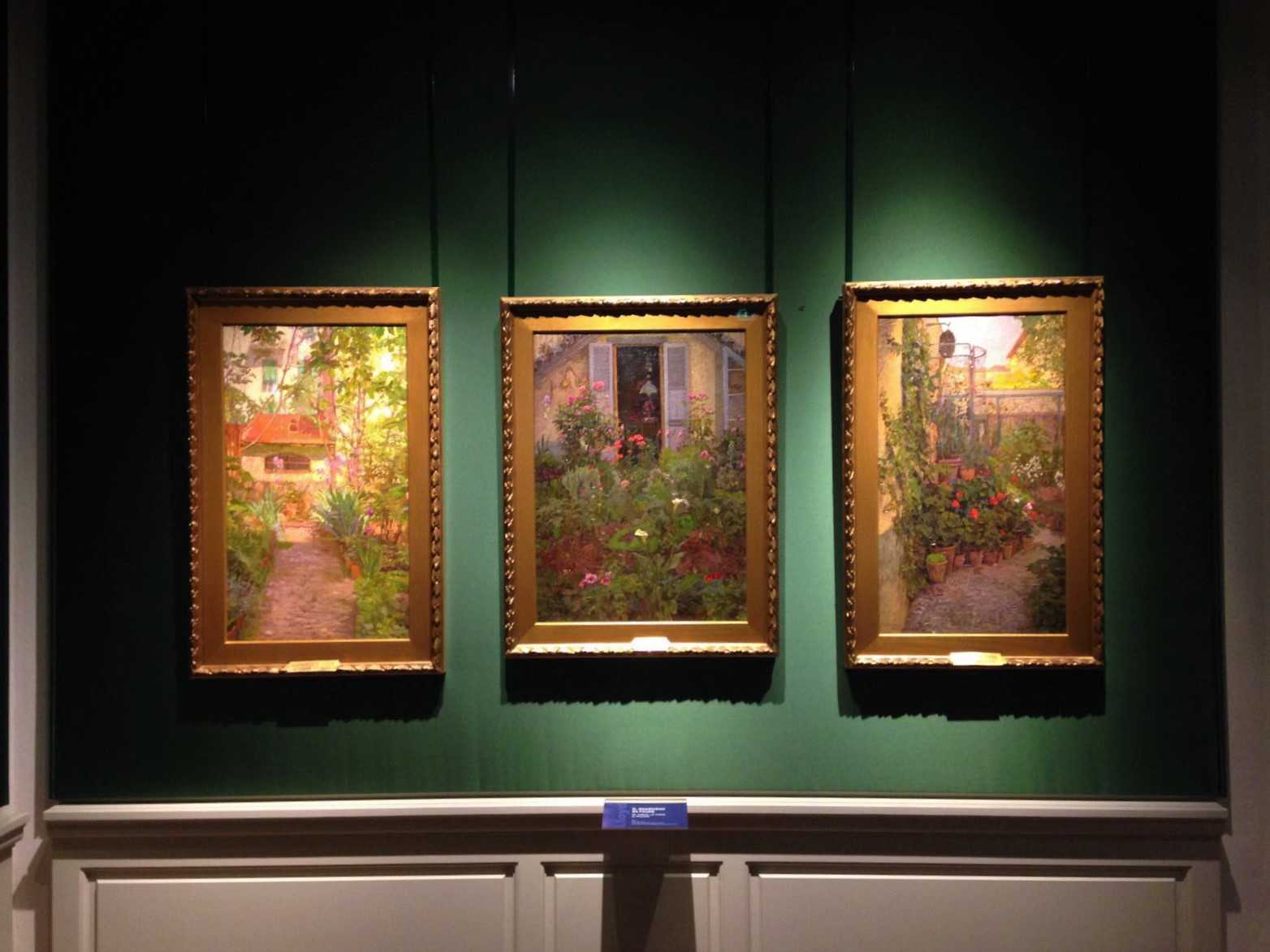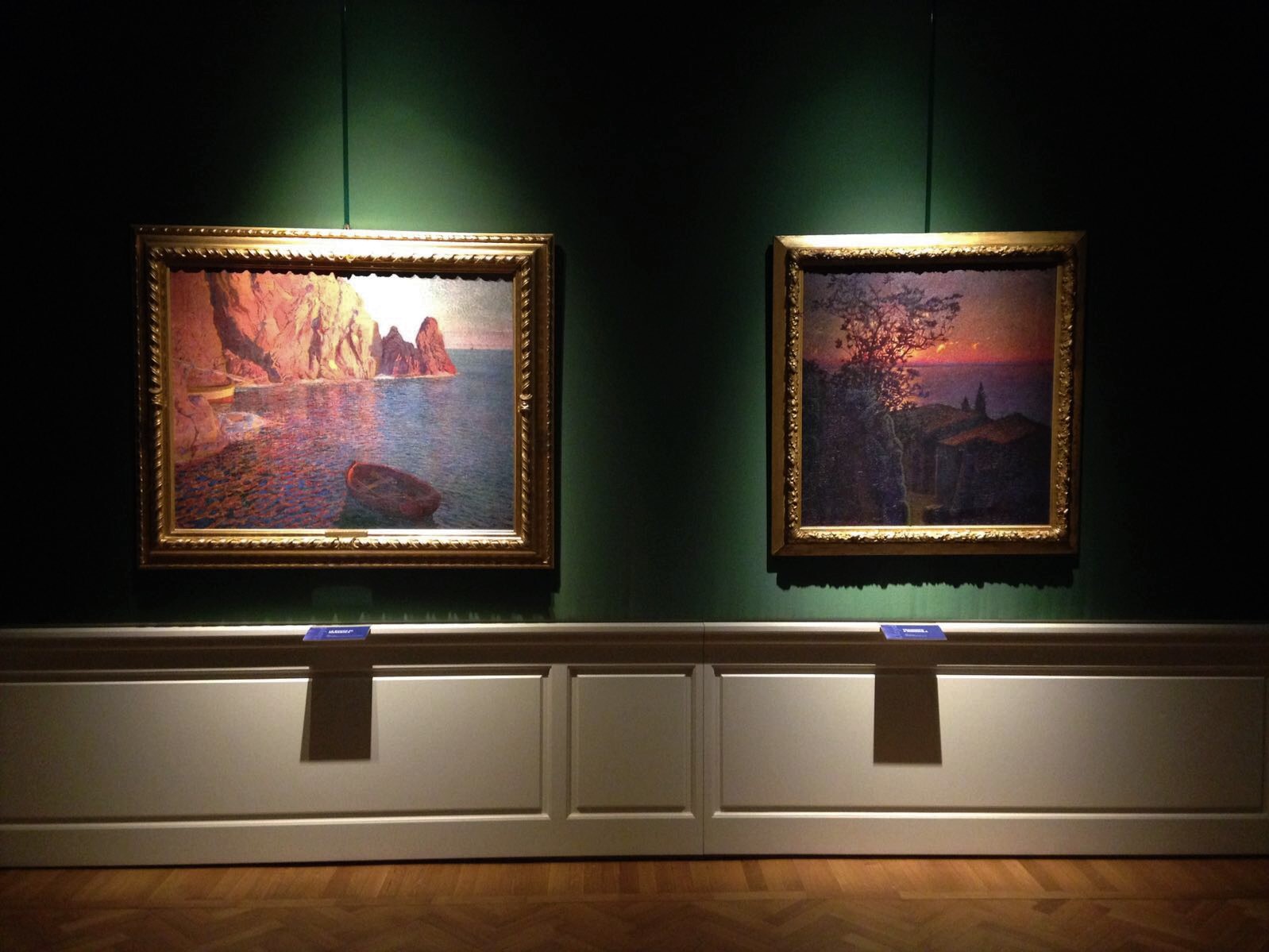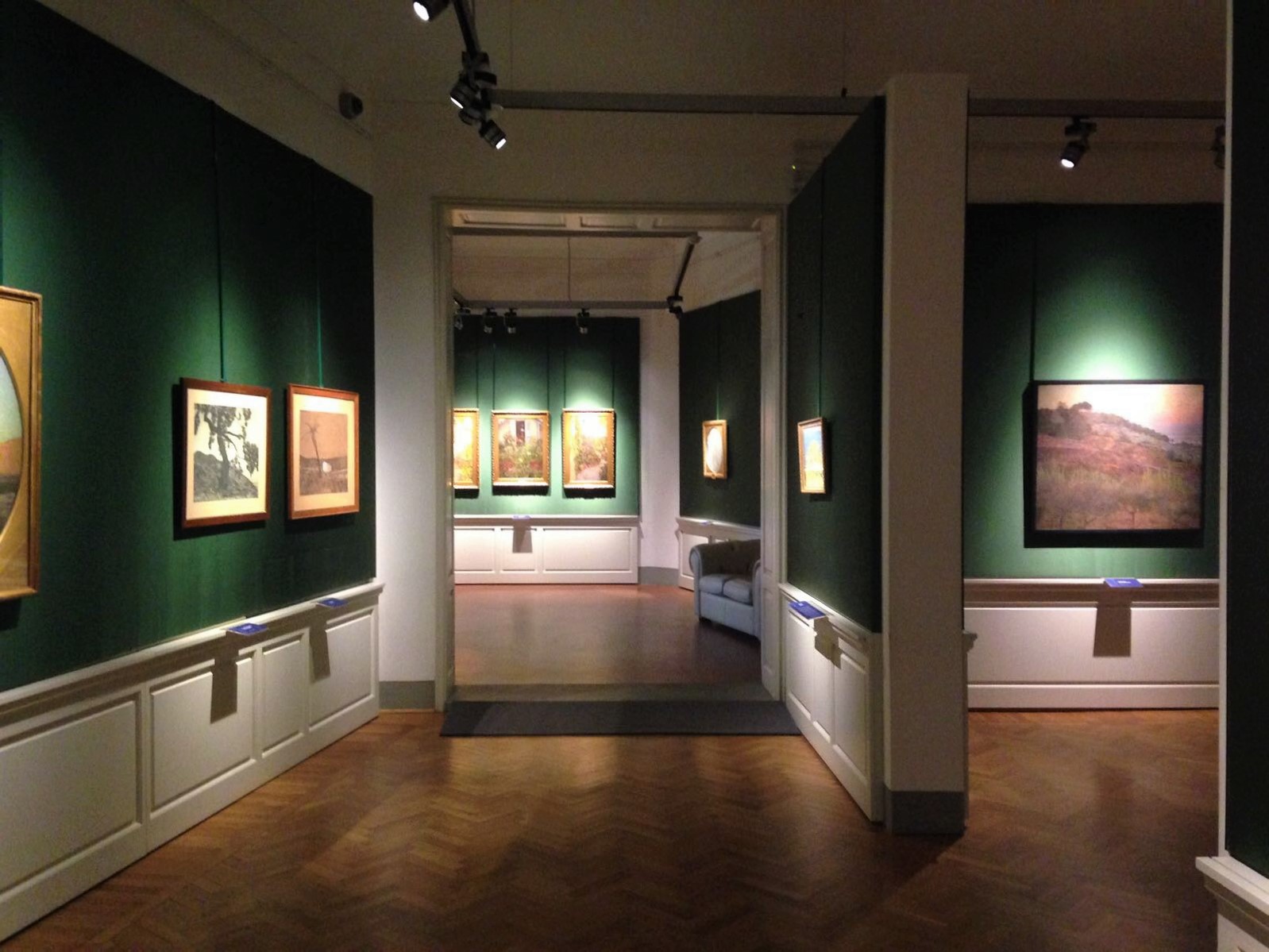

14 luglio 2017 – 7 gennaio 2018
Villa Bardini, Firenze
Di Giulia Bertelli (Università degli Studi di Firenze)
Fino al 7 Gennaio si terrà a Firenze, al terzo piano di Villa Bardini, la mostra “Lloyd. Paesaggi toscani del Novecento”, curata da Lucia Mannini e promossa dalla Fondazione Cassa di Risparmio di Firenze in collaborazione con la Fondazione Parchi Monumentali Bardini Peyron e il patrocinio della Regione Toscana e del Comune di Firenze.
La rassegna è l’ultima, in ordine cronologico, di una serie di esposizioni d’arte organizzate nella villa fiorentina per documentare e far conoscere al più ampio pubblico possibile, i diversi movimenti e i tanti artisti che sono stati protagonisti dell’arte figurativa toscana tra Ottocento e Novecento.
Llewelyn Lloyd (1879-1949) nasce a Livorno da padre gallese e madre livornese. Compie la prima formazione nella sua città natale presso lo studio di Guglielmo Micheli, allievo di Giovanni Fattori, dove stringe amicizia con giovani artisti, tra i quali Amedeo Modigliani e Oscar Ghiglia, e consolida l’ammirazione verso il “Maestro”, come Lloyd chiama Fattori nelle sue memorie, raccolte nel volume postumo “Tempi andati”, pubblicato nel 1951 a cura di Roberto Papini e nel 2007 rieditato a cura di Dario Matteoni.
Lloyd giunge a Firenze nei primi anni del Novecento per seguire i corsi del “Maestro” all’Accademia di Belle Arti e in questa città scopre i nuovi sviluppi dell’arte italiana ed europea che si riveleranno molto influenti nel suo percorso artistico. Partendo, infatti, dalla lezione macchiaiola, nel corso della sua carriera, Lloyd innesta a questa scelte cromatiche e soluzioni compositive dedotte dallo studio delle sperimentazioni post impressioniste che stavano prendendo campo in Italia in quegli anni: il divisionismo e il sintetismo.
La mostra ripercorre le stagioni pittoriche della carriera artistica del pittore livornese dai primi anni del Novecento fino agli anni trenta, dimostrando come, sebbene la sua opera sia ritenuta troppo spesso un’appendice della pittura macchiaiola e il suo lavoro confinato ad un ambito prevalentemente regionale, Lloyd sia, in realtà, un protagonista e un innovatore dell’arte italiana del ventesimo secolo, come lui stesso desiderava essere ritenuto.
Le prime sale raccolgono i dipinti della stagione divisionista di primo Novecento, quando Lloyd sperimenta le possibilità illuministiche offerte dalla nuova tecnica. Paesaggi marini e dell’entroterra toscano e ligure sono resi con paste cromatiche dense dalle tonalità vivaci e brillanti. La vera protagonista delle opere è la luce, dell’alba e del tramonto, come si vede in Rocce di Manarola e Tramonto a Manarola del 1904.
Seguono le opere della fine degli anni Dieci, nelle quali il pittore torna a riflettere sulla pittura macchiaiola e dà vita a scene di intima quiete nelle quali evoca gli affetti domestici attraverso significativi dettagli, come i giochi dei bambini distrattamente lasciati a terra e il tavolo rustico apparecchiato che si scorge dal portoncino aperto in L’ombra del pergolato del 1909. Scorci dell’amata Isola d’Elba, giardini fioriti come nel trittico Il giardino in fiore. Il viale, la casa, il pozzo del 1907 e angoli di casa sono restituiti sulla tela con colori delicati e una pennellata corposa e più larga della precedente, in cui le ombre prevalgono sulla luce.
Nel breve corridoio della villa rivolto verso la città e l’Arno, come se i dipinti esposti fossero il riflesso di quanto si vede affacciandosi dalle finestre, trovano posto le nostalgiche vedute di Firenze e dei luoghi della città in prossimità della campagna, degli anni Trenta.
La concisione formale contraddistingue le marine, le barche, e i familiari angoli della città dipinti negli anni Venti, che sono raccolti nelle sale che chiudono la mostra, nelle quali i toni caldi del giallo e dell’ocra contrastano con i blu e gli azzurri del cielo e del mare, colpisce fra tutte Barconi all’ormeggio del 1926.
Una piccola stanza è infine dedicata alla grafica. Qui sono intimamente raccolti i disegni che ritraggono la figlia e la moglie del pittore e i dipinti che raffigurano l’interno del suo studio e della sua casa. Lloyd dava molta importanza al disegno, del quale si serviva per appuntare immagini e colori che poi avrebbe riportato sulla tela.
Nelle sale la luce è rivolta solo verso le opere, lasciando il resto dell’ambiente soffuso. I colori e i contrasti cromatici spiccano dallo sfondo verde bottiglia delle pareti su cui sono appesi i dipinti e tutto trasmette quel senso di intimità, familiarità e pace caratteristico delle opere di Lloyd.
Peccato che i pannelli e le didascalie presenti sotto ogni opera siano solo in italiano, vista la sede della mostra, descrizioni in lingua straniera avrebbero reso la vita e la carriera del pittore comprensibile anche ad un visitatore straniero.
Sebbene la mostra riesca nel suo obiettivo di presentare la carriera artistica di un importante esponente dell’arte figurativa toscana del Novecento, spesso ignorato, credo che sia più adatta a chi già conosce il periodo storico artistico in cui Lloyd ha vissuto, piuttosto che ad un pubblico poco addentro all’argomento, se non altro, per avere dei termini di paragone con quanto veniva fatto dai suoi contemporanei e capire come mai il pittore possa essere considerato un innovatore.
Accompagna la mostra il catalogo a cura di Lucia Mannini con testi di Mattia Patti, Umberto Tombari e Jacopo Speranza.
Villa Bardini – Costa San Giorgio, 2 e via dei Bardi, 1r
orario: dal martedì alla domenica dalle 10.00 alle 19.00 (ultimo ingresso ore 18.00)
Lloyd. Tuscan Landscapes of the Twentieth Century

14 July 2017- 7 January 2018
Villa Bardini, Florence
Translated by Nona Debenham (Istituto Lorenzo de’ Medici)
Until January 7, on the third floor of Villa Bardini, on view is the exhibition “Lloyd. Tuscan Landscapes of the Twentieth Century “, curated by Lucia Mannini and promoted by the Fondazione Cassa di Risparmio of Florence in collaboration with the Fondazione Parchi Monumentali Bardini Peyron and the patronage of the Tuscany Region and the City of Florence.
The exhibition is the latest in a series of chronological art exhibitions organized at Florentine villa. The exhibitions document and aim make known to the largest possible audience, the various movements and the many artists who have been the protagonists of Tuscan figurative art between the Nineteenth and twentieth centuries.
Llewelyn Lloyd (1879-1949) was born in Livorno to a Welsh father and Livornese mother. He completed his first training in his hometown at the studio of Guglielmo Micheli, a student of Giovanni Fattori. During his time there he created friendships with many young artists, including Amedeo Modigliani and Oscar Ghiglia, and reinforced his admiration for ‘Master’ as Lloyd calls Factori in his memoirs. Lloyd’s memories were collected and published in 1951 posthumously in, “Times gone” written by Roberto Papini and then re-edited by Dario Matteoni in 2007.
Lloyd arrived in Florence in the early twentieth century to attend courses, with the ‘Master’ at the Academy of Fine Arts. During his time in the city, he discovers the new developments in Italian and European art that became very influential in his artistic career. In fact, starting during his lessons with Machiavilo, and continuing through his career, Lloyd makes chromatic choices and compositional solutions derived from his study of post-Impressionist experiments that were taking place in Italy in those years: divisionism and synthesis.
The exhibition retraces the pictorial styles of the artistic career of the Livornese painter from the early twentieth century to the thirties, demonstrating how, although his work is too often considered to be an appendage of the painting machine and his work confined to a predominantly regional scope, Lloyd is, in fact, a protagonist and an innovator of 20th century Italian art, as he himself wanted to be considered.
The first room shows his paintings from the early 20th-century divisionist era, in which Lloyd experimented with the possibilities offered by the new technique. Tuscan and Ligurian marine landscapes and the Tuscan countryside are made with dense chromatic pastes of lively and brilliant shades. The real protagonist of the works is light, dawn and sunset, as seen in Rocks of Manarola and Sunset in Manarola, both completed in 1904.
Following these works, the painter returns to reflect on Macchiaioli style of painting and to give life to intimate silent scenes in which he evokes domestic affections through meaningful details, such as the games of children distractedly left to the ground and the rustic table which is seen from the door open in The Shadow of the Arbor of 1909. Glimpses of the beloved Elba Island flowered gardens as in the triptych, The flowering garden. In the painting, the avenue, the house, the well of 1907 and the corners of the house are restored to the canvas with delicate colors and a shimmering brush and wider than the previous, where shadows now prevail over the light.
The exhibition continues in the short corridor of the villa facing the city and the Arno, it is as if the painting was the reflection of what you can see from the windows; the nostalgic views of Florence and the city’s places near the countryside of the 1930s.
Characterized by the warm tones of yellow and ocher which contrast with the blue and blue sky and the sea, the viewer can see Barconi all’ormeggio completed in 1926, alongside the marinas, boats, and the familiar corners of the city that Lloyd painted in the 1920s. These works are displayed in the last halls to mark the formal conclusion of the exhibition.
Finally, a small room is dedicated to graphics. Here are intimately collected drawings depicting the daughter and wife of the painter and paintings depicting the interior of his studio and his home. Lloyd gave much importance to the drawing, he used to pin pictures and colors that he would then bring on the canvas.
In the rooms the light is directed only to the works, leaving the rest of the room dim. The colors and contrasts of colors stand out from the green background of the walls on which the paintings are hung. They all transmit that sense of intimacy, familiarity and the peaceful characteristic of Lloyd’s works.
It is a pity that the panels and captions present in each work are only in Italian, given the venue of the exhibition, descriptions in a foreign language would make the life and career of the painter understandable foreign visitors.
Although the exhibition succeeds in the goal of presenting the artistic career of an important Tuscan art figure of the twentieth century, who is often ignored, I think it is more suitable for those who already have an art history background and know about the time in which Lloyd lived, rather than a public, who has little knowledge on the subject. If anything, it would be beneficial to have a comparison with what was done by his contemporaries and understand how the painter can be considered an innovator. The exhibition shows the catalog by Lucia Mannini with texts by Mattia Patti, Umberto Tombari and Jacopo Speranza.
Villa Bardini – Costa San Giorgio, 2 and via dei Bardi,
Tuesday to Sunday from 10.00 to 19.00 (last entry at 18.00)